Among New York City’s numbered avenues, 1st through 12th, 4th Avenue has always been the odd duck– you can tell just by looking at a map. While most avenues are extraordinarily lengthy, spanning much of the island from north to south, 4th runs just six short blocks between Cooper and Union Squares; and while all of NYC’s numbered avenues run parallel to the island’s northward tilt (though not true north) 4th runs northwest athwart the other avenues, forming a “V” at the Bowery at Cooper Square. If it were permitted to continue on its general path uptown it would intersect with 5th Avenue at about 27th or 28th Street.
At one time 4th Avenue ran north between its numbered partners, 3rd Avenue and 5th Avenue….all the way to the Harlem River uptown.
ABOVE: Park Avenue South and West 23rd Street
Today’s 4th Avenue runs athwart the overall Manhattan grid because it is one of the oldest roads on the island, being (along with The Bowery itself) a remnant of the old Bowery Road — a colonial path that overlaid a Native American trail. Manhattan’s present grid was laid out on maps in 1811. Therefore, 4th Avenue doesn’t follow the grid since there was no grid system of streets when people first walked or drove horses on it.
As delineated in my Street Necrology: Classified 4-A page, 4th Avenue’s physical history is defined, in large part, by the coming of the iron horse in the mid-19th Century. By 1832 the New York and Harlem Railroad ran on The Bowery, pulled by real horses that far downtown, from about Centre Street north to 14th. The line intended to reach Harlem, and thecity permitted the NY&HRR to extend north along what would become 4th Avenue, then still a figment of city planners’ imaginations. Railroads at the time were filthy, noisy and dangerous, especially in a burgeoning urban environment, and only the poor and the attendant crime element would live along the route.
The city could take no more. Something had to be done –and the city took action. A tunnel was cut between East 33rd and 38th Streets in the 1850s to contain the steam belchers, and the city placed a landscaped garden path above the cut, renaming 4th Avenue Park Avenue at that point.
Eventually the city made 42nd Street the furthest point south the steam rails could travel, believing falsely that civilization would never extend north of there (a mistake the city had previously made decades earlier by placing City Hall at the junction of Broadway and the Bowery Road). The city continued to relentlessly expand, however, and steam railroads continued to plague an increasingly genteel district.
The city continued to rename the route Park Avenue in sections above that point. By 1896, even the sections of road in the Bronx alongside the railroad, now either elevated, in a tunnel, or in an open cut, were renamed Park Avenue, and today, walking along gritty Park Avenue in, say, Morrisania or Fordham, you have to remind yourself that this is indeed the same Park Avenue that accommodates the Lever House and St. Batholomew’s Church a few miles to the south.
Forgotten Fan Darian Jon Fernando has some additional information: Actually, the renaming of Fourth Avenue … extended down to 34th Street until 1924. In that year, a real estate developer names Henry Mandel made a deal with the city to extend Park Avenue down 2 blocks so his new development on the East side of the Avenue between 32nd and 33rd Streets could be named “One Park Avenue”. (Just like today, a good sounding address is worth jumping through hoops for.) Could any developer pull off a thing like that in 2009? Somehow, I seriously doubt it!
BTW: I found this information in “New York’s Architectural Holdouts” by Andrew Alpern and Seymour Durst, where there is an interesting back-story concerning the original holder of the “One Park Avenue” title.
By the mid-20th Century, residents along 4th Avenue from East 32nd south to Union Square petitioned to become a part of Park Avenue as well. Their dream didn’t exactly come true — doing that would force a change in house numbers for Park Avenue’s entire length because the Bronx numbers are an extension of Manhattan’s — but the City Council did officially change Fourth to Park Avenue South on May 5, 1959. (A similar situation arose in the1910s when 7th Avenue was extended south to accommodate the IRT subway; the extension became 7th Avenue South, for reasons much along the same lines. That leaves the short run from Cooper to Union the only remaining stretch of 4th Avenue.
The two buildings shown above, along Park Avenue South, contain reminders of Park Avenue South’s original name.
I began my 4th Avenue survey at the “V” formed by the junction of The Bowery and Cooper Square. Some mapmakers, Hagstrom in particular, have insisted on marking the two streets of the V as 3rd and 4th Avenues, but the city’s Department of Transportation, the only opinion that counts, marks both from the fork at East 4th north to St. Mark’s Place as “Cooper Square.” 4th Avenue continues Cooper Square’s street numbering.
A brace of new buildings, some commissioned by Cooper Union, some not, have appeared on The Bowery and Cooper Square; in 2009, The Bowery is rapidly evolving into an up-market residential district, something its former down-and-outers as well as the carny hawkers, ragged actors, and hot corn girls who paraded the route before the bums got there, all of them shrouded by the Third Avenue El over each sidewalk, could scarcely have imagined.
The tall building at left, unofficially called the Shark’s Fin, is the new Cooper Square Hotel, completed in 2008 by the Carlos Zapata Studio. The corner building, housing the Dolphin Restaurant in 2009, has been home to Beat Generation poets and musicians in times gone by, including LeRoi Jones (Amiri Baraka) and Diane DiPrima. There has been a succession of trompe l’oeil artwork on the side of the building.
Music publisher Carl Fischer, and the gigantic note visible from Cooper Square (not shown here, but you can’t miss it) have been an indelible part of Cooper Square for many years. Patriarch Fischer (1849-1923) immigrated from Germany in 1872 and was succeeded by his son Walter Fischer and later, son-in-law Frank Hayden Connor. Fischer Music was located in Cooper Square from the late 19th Century, but in 1923 the firm constructed its 12-story office building, later with the Big Note, which continued to house company offices until 1999. Above, we see the Fischer Building behind a large Coca-Cola ad (this spot is now filled by the “undulating” Gwathmey Astor Place luxury loft building). At right is an ad on East 16th Street just east of Union Square for Fischer Musical Instruments, a 1930s offshoot of the music publisher. Though the Fischer Building is now luxury lofts as well, they have piquantly redone the Big Note just recently. Meanwhile, Fischer still has an online presence as well as offices at 65 Bleecker Street in NoHo.
Who is that guy? Inventor and industrialist Peter Cooper himself, who here turns his back on the school he founded in 1857. From FNY’s View From the Coop page:
Cooper Square (Astor Place at 3rd and 4th Avenues), was named for industrialist and inventor Peter Cooper (1791-1883), the developer of the first practical steam engine. He helped build America’s iron and cable industries (partnering with Samuel Morse in laying the first trans-Atlantic cable), and was one of the first developers of gelatin made from rendering mammal remains. In 1857 he founded ?Cooper Union for the Advancement of Science and Art in a new brownstone building at one of Manhattan’s true crossroads, the Bowery (originally the Post Road) and Astor Place, once known as Art Street. The building is supported by steel rails invented by Cooper himself.
The statue was produced in 1894 by NYC-raised sculptor Augustus Saint-Gaudens (1848-1907), with the pediment desined by Stanford White. Saint-Gaudens’ other major works include portraits of Admiral David Farragut in Union Square; a standing Lincoln in Lincoln Park, Chicago, and a seated Lincoln in Grant Park, Chicago; the Robert Gould Shaw Memorial in Boston Common; the gilded General William Tecumseh Sherman in Grand Army Plaza, Central Park; and the Charles Stewart Parnell monument in Dublin, Ireland (Sain-Gaudens was born in Dublin and spent the first 6 months of his life there, before his family emigtated to the USA).
Cooper Union Foundation building, facing Astor Place on Cooper Square. Cooper acquired land here early in his career, after running a grocery on nearby Stuyvesant Street. When the time had come to found this institution, he deliberately placed it at this crossroads to mediate class divisions; even in the mid-19th Century, Broadway and the Bowery were on different levels.
The “Union” in the name comes from the important junction of roads, but also the union of art and science and the Union of states, in the late 1850s beginning to sunder by the questions of abolition and states’ rights. The Union’s second coup was Abraham Lincoln’s appearance here in early 1860, kicking off his presidential campaign. (According to legend, after the speech Lincoln repaired to McSorley’s Ale House on East 7th, if indeed it was there at the time; whether he had the light or the dark was unrecorded.) The first great Cooper Union speaker was Mark Twain, as he gave the building’s kickoff lecture in 1859. Every US president followed Lincoln’s suit until Woodrow Wilson (who was followed, ironically, by a succession of ineffective Republicans). The large arched windows were once display windows, as Cooper Union housed ground-floor stores that subsidized the school.
Looking at the photo above left you see a cylindrical “protuberance” on the left side. Cooper designed the building with space for an elevator, even before such a mad concept had been practically demonstrated. (Instead, the first Otis elevator was installed in the Haughwout Building on Broadway and Broome Street in SoHo in the same era.)
Of course, your webmaster was impressed by the light stanchions, which must have at one time been gaslit.
This 1942 exposure by one of the 20th Century’s most prolific, yet unsung photographers, Charles Cushman, shows Cooper Square and the Cooper Union Foundation Building as they were in 1942. The building just north of it, the 1853 American Bible Society building, has disappeared to be replaced by a nondescript Cooper Union engineering lecture hall and classroom building it hopes to demolish and replace with a high-rise. The Met Life tower and the King of All Buildings loom further uptown.
And here is that nondescript lecture hall building. What’s more interesting here at Astor Place (foreground) and Cooper Square are what you see here in the triangle formed by the Square, Astor Place (front) and Lafayette Street — Alamo, the turnable black cube installed by sculptor Tony Rosenthal in 1967. What is little remembered is that the statue of Samuel S. Cox, Ohio congressman, Coast Guard sponsor, and mailman’s friend, originally stood here before being shuffled off to Tompkins Square Park. We will get to that subway kiosk in the rear presently. Slight panic occurred in 2005 when Alamo was removed for restoration for a few months in 2005.
Wanamaker’s. One of the few buildings in NYC to occupy an entire square block (Macy’s doesn’t, for example) the former John Wanamaker department store was designed by Daniel H. Burnham (who also helmed the Fuller, or Flatiron, Building completed in 1902, the same year this masterpiece took its place in Cooper Square). Believe it or not this building is an annex, an addition to the Alexander Turney Stewart & Company dry goods store on Broadway; when the Stewart store began to founder in 1896, Wanamaker rode in from Philly and built what you see here. Wanamaker’s remained in business until 1954. Since then Department of Motor Vehicles offices have occupied the building, as well as the K-Mart (formerly Kresge’s) on the ground floor. The building’s original staircase connecting to to the Astor Place IRT station is still there.
On the left of the photo, you can see a part of the Charles Gwathmey Astor Place luxury loft, “Sculpture For Living,” a building that Miss Representation finds “sickeningly unpleasant” although your webmaster has something of a soft spot for it. It’s academic, anyway, since I am still awaiting my Magamillions ship to come in and will never be able to live there.
The sailors in Green and Comden’s On the Town list Wanamaker’s as a preferred destination, and the 5th Avenue bus’s southern end used to be called the Wanamaker Terminal. Just north of the venerable department store, you can see the Stewart House, named for the Irish entrepreneur and real estate mogul who pioneered Ladies Mile retail in the 1800s, and who also created the Long Island town of Garden City and built a short-lived railroad to connect it to NYC. Cruisegoer Leon Klinghoffer, who was pushed to his death into the Mediterranean Sea from the liner Achille Lauro by Palestine Liberation Front terrorists in 1985, resided there.
A look south from Astor Place as we see Cooper Union and Cooper Square Hotel. The Square’s new buildings have been derided in some architectural schools but I welcome the contrast between the Italianate 1850s trade school and the glass-walled 21st Century buildings that will accompany it. I’m reminded of Copley Square in Boston, where the Romanesque H. H. Richardson Trinity Church can be seen in distorted reflection on the nearby John Hancock Tower.
That mad manipulator of crockery, Jim Power, is still doing what he has done for 25 years — decorating lamppost bases with various detritus that he glues on to the posts — despite the DOT’s best efforts to thwart him (though the DOT has gotten on board with him of late — persistence pays!). RIGHT: some lampposts in Cooper Square do a devil’s combination of octa-pole bases and shafts with Donald Deskey masts, a combination that is an esthetic train wreck.
Bike
“I’ve got a bike, you can ride it if you like, it’s got a basket, a bell that rings, and things that make it look good/I’d give it to you if I could but I borrowed it…” — Syd Barrett
Cooper Union students park their bikes here on a pethora of bike-securing devices.
LEFT: Official NYC bike-lock stanchion.
ABOVE: the old reliable, a slotted signpost, is just as good as the new stuff. RIGHT: Most NYC drivers firmly aver that noise is necessary.
At one time, all IRT subway entrances had kiosks like this one. I say entrances — there were entrances and exits, and the exits had their own design. As auto traffic became more and more prevalent, drivers discovered that these massive kiosks ruined sightlines, and more and more accidents occurred; thus the IRT began phasing them out, removing the last one in the early 1960s. However, when the Astor Place station was restored in the mid-1980s, it was decided to replicate the entrance kiosk, and this is it. There is always a line for the Mud coffee truck here.
Ah, at East 9th, we’re finally on 4th Avenue proper. Looking south on the photo left, past the Gwathmey tower and old Wanamaker’s, as Lafayette Street’s traffic feeds onto 4th Avenue. RIGHT: in a campaign that screamed “please deface me” the longrunning FOX-TV cartoon King of the Hill installed some large ads around town in the fall of 2008.
East 10th Street: a handsome 1930s-era apartment on the NE corner and across the street, a Benjamin Moore paint store. Moore, an immigrant Irishman, opened his first store on Atlantic Avenue in Brooklyn, in a spot now occupied by the Brooklyn-Queens Expressway.
Though historic Grace Church fronts on Broadway where it bends at East 10th Street, it maintains a presence on 4th: an opening between buildings vouchsafes a glimpse. RIGHT: East 11th Street is interrupted between Broadway and 4th Avenue by James Renwick Jr.’s 1883 Grace Memorial House, which was reputedly the first day care center in NYC. 11th Street is interrupted, according to legend, because landowner Henry Brevoort refused to budge when the streets were being cut through in the early 19th Century. By contrast, 11th was bruited through the Second Shearith Israel Cemetery on West 11th Street near 6th Avenue, forcing the disinterment of remains and reinterment in a cemetery on West 21st just off 6th.
The furiously Moderne Cooper Station Post Office, NE corner of 4th Avenue and East 11th. It was constructed in the mid-1930s by the Works Progress Administration. This is the PO where Newman, the scheming postman from Seinfeld played by Wayne Knight worked.
The routine-looking 115 4th Avenue with the gym on the ground floor actually recalls two historic figures in the Cooper-Union Square area. “Petersfield” was the mansion belonging to Petrus Stuyvesant, great grandson of Peter Stuyvesant, Director General of New Amsterdam in the colonial era. It was located on a high hill, long since leveled, overlooking the East River at approximately where 1st Avenue and East 15th Street are now.
The Stuyvesant property contained grassland, hills, meadows, ponds and rivulets; one of which, the Crommessie Fly, later was shortened by the British to “Gramercy.” There were also Native American gravesites. Petersfield, the mansion, was in ruin by the mid-1830s; by then, the Manhattan grid was cut through and the area was increasingly urban. Few relics of the Stuyvesant property persisted into later years, though a pear tree planted by Peter Stuyvesant himself in 1647 remained at the corner of 3rd Avenue and East 13th Street until 1867, when it was run into by a horsecart. And, Stuyvesant Street, which breaks the grid pattern between 3rd Avenue and East 9th Street and 2nd Avenue and East 10th Street, was originally the driveway to Peter Stuyvesant’s mansion (it burned down in 1778, perhaps torched by British occupiers during the Revolutionary War).
The Fish Building recalls the prominent (in politics and the military) Fish family of New York state. I found an unusual building called “Hamilton Fish Court” several years ago that also recalls this family, whose leading light was Hamilton Fish (1808-93) who duplicated DeWitt Clinton’s feat in becoming a US Representative from NY State, a Senator from NY State, and NY Governor.
Book Row
From 1910 to the early 1960s lower 4th Avenue’s (there was an upper 4th then) most prominent attribute was its dozens of used book stores…
In a leisurely age that seems not so long ago, husbands and wives could always find plenty to do in the area around Broadway and 10th Street. The big attraction was the splendid old store of John Wanamaker with its 10 floors of frippery and folderol designed to absorb hours of any fashionable lady’s time. And for the husbands, to make their wait not only palatable but actually pleasant, there were Fourth Avenue’s antiquarian book stores. That period – the 20’s and 30’s – was the golden age for Booksellers’ Row, and it’s a time, unfortunately, that has passed forever. Wanamakers is gone, burned down four years ago, and the promoters, speculators, and builders who have been laying waste to the whole region are now beginning to nibble at the edges of Booksellers’ Row itself.
Some bookmen have already moved out, their shops demolished or their leases transferred to other businesses able to pay the rising rents more commensurate with those of the rising apartment buildings which are beginning to fill the district. Of the shops that remain, at least half are living on borrowed time, paying their rents from month to month and always uncertain of how much longer their buildings will remain standing. Village Voice, February 16, 1961
According to veteran humorist Fran Leibowitz, many of the shopowners were distinctly gruff and inhospitable in the old-fashioned New York style; they “acted more as if you had broken into their house and were stealing their books.” Thirteen.org
One of the old 4th Avenue veterans, The Strand, moved several decades ago to Broadway and West 12th Street and expanded greatly, though it remains labyrinthine and hard to negotiate. A new used bookstore, Alabaster Books, has appeared in the last few years and who knows, 4th Avenue may become “booksellers’ row” again.
The International Tailoring Company building at 4th Avenue and East 12th was constructed in 1921, but its monogrammed initials hark back to the Beaux Arts era a couple of decades earlier. Some more detail can be found at NYCJPG.
Though most of the book sellers have gone, 4th Avenue has become an unlikely hotbed for Halloween costumes, or for any other time of year. Halloween Adventure is on the ground floor of the 1888 building The Renwick. RIGHT: a great escape at 112 4th Avenue
Blimpies seem to be dying off in NYC as Subway seems to be finally winning the battle between the hero titans (hoagies, for you folks in Philly, grinders for Boston). Blimpies are a much better buy than Subway, as the portions are a lot thicker. I’ve had good Blimpies here at 4th and 13th, but not-so-good ones with almost stale bread. The Yankee poster is from 1988, the only year Jack Clark (lower right) was a Yankee. In the background is NYU’s School of Continuing and Professional Studies.
In a practice occurring with greater frequency around town, a building interior is being gutted with just the facade remaining; an 11 or 14-story condo called Rising Sun will go here, with the older shell retained for effect. Probably the most prominent example of this is the Sir Norman Foster Hearst Tower on 8th Avenue and West 57th Street. While it was still a going concern this building hosted the popular clubs Plaid and earlier, Cat Club.
The Cat Club was the first place I ever saw my beloved Killing Joke circa 1989. In the crowd with me were Joey Ramone (who lived nearby at the time), Handsome Dick Manitoba and Johnny Feedback of Kraut. Also saw the oft-forgotten Primitives there (remember “Crash”?) When it morphed into the Grand, I saw Big Country, Ethyl Meatplow, Cranes, Redd Kross, Motherhead Bug, Mephiskapheles and the almighty COP SHOOT COP there a few times. It was one of my favorite live venues for a while. Sigh. So much for that. comments, Vanishing New York
Ladies and gentlemen, boys and girls, The Ugliest Building in NYC. This thing resembles a giant vent shaft. It is in fact the Union Square 14, a multiplex theatre with 14 screens. The Broadway side facing Union Square is the faltering Virgin Megastore, which will probably go away soon (2009). Too bad — I like the big music megastores, but ’twas Apple killed them with easily downloadable Itunes on Ipods, carried by Ipeople. Compare it to the 1893 Cornelius Roosevelt Buiding on the far left, its facade filled with Easter eggs like terra cotta devils’ heads and initials.
4th Avenue ends at Union Square, with Park Avenue South taking its place from East 17th Street on north. The NE corner of Union Square has been occupied by the twin Zeckendorf Towers since 1987 (they block the clock tower of the fab 1914-1926 Con Ed Building. But before that, this was S. Klein On the Square, shown here during its demolition in 1978.
SOURCES: Jim Naureckas’ New York Songlines
Kenneth Dunshee’s As You Pass By
Gerald R. Wolfe’s New York: A Guide to the Metropolis
ForgottenFan Larry Rogak passes on a blog dedicated to an avenue even shorter…13th Avenue. Hmmmm….

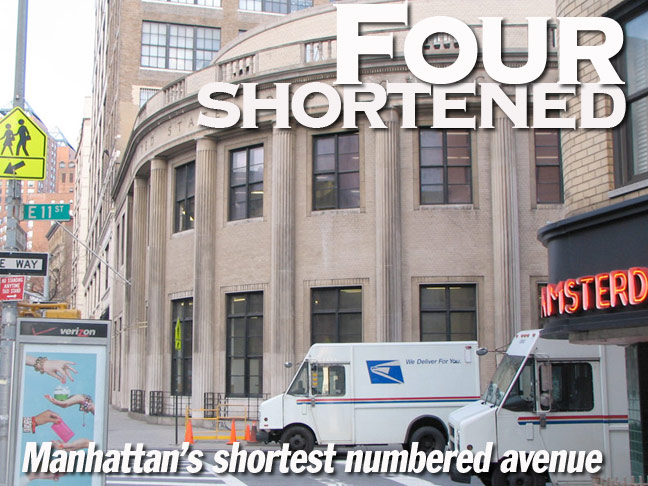
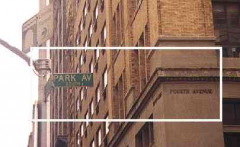
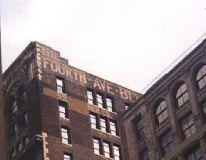
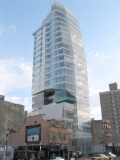
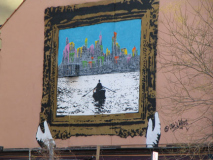
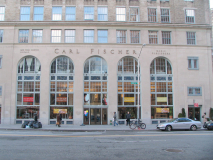
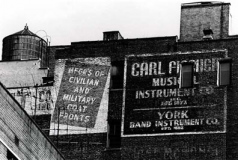
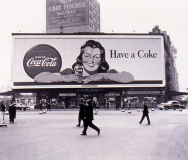
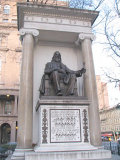
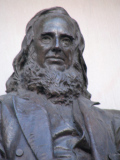
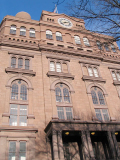
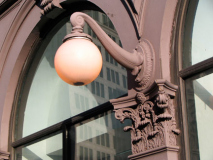
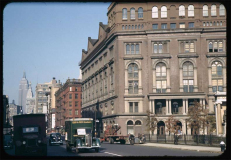


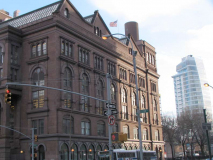
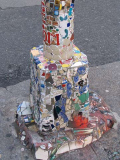
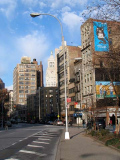
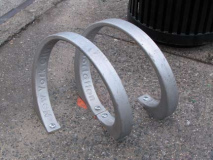

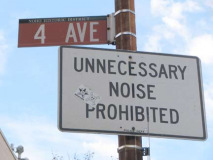
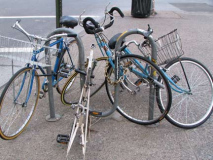
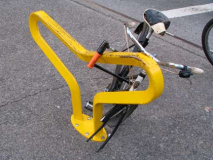
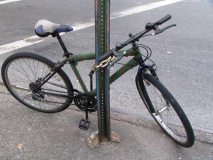
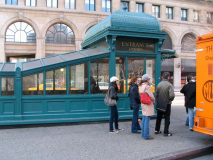
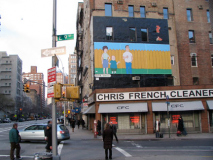
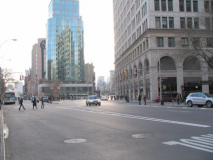
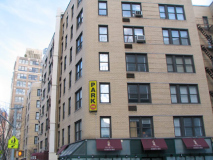
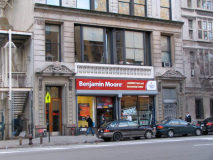
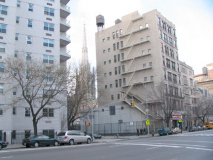
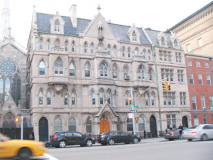
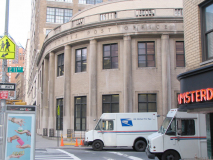
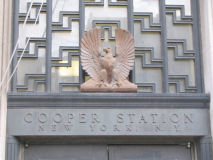
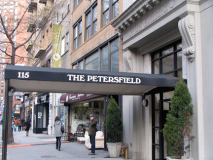
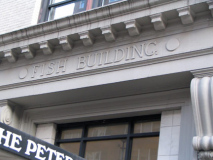

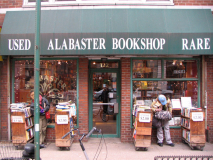
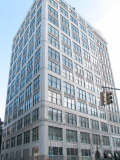
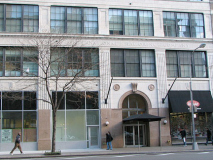
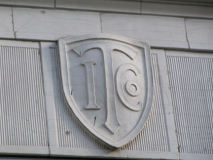
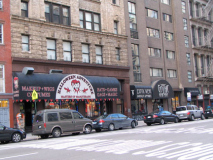
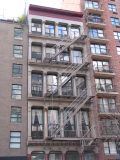
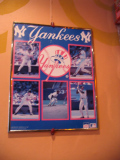
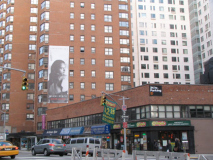
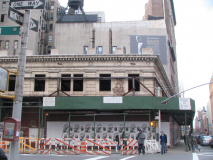
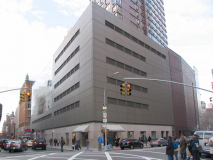
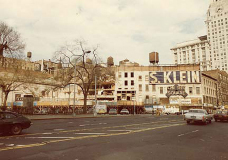
1 comment
[…] Forgotten New York. https://forgotten-ny.com/2009/01/four-shortened-manhattans-shortest-numbered-avenue/ […]
Comments are closed.